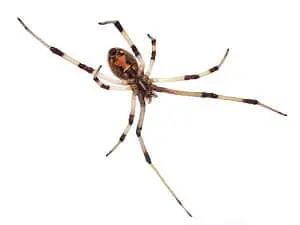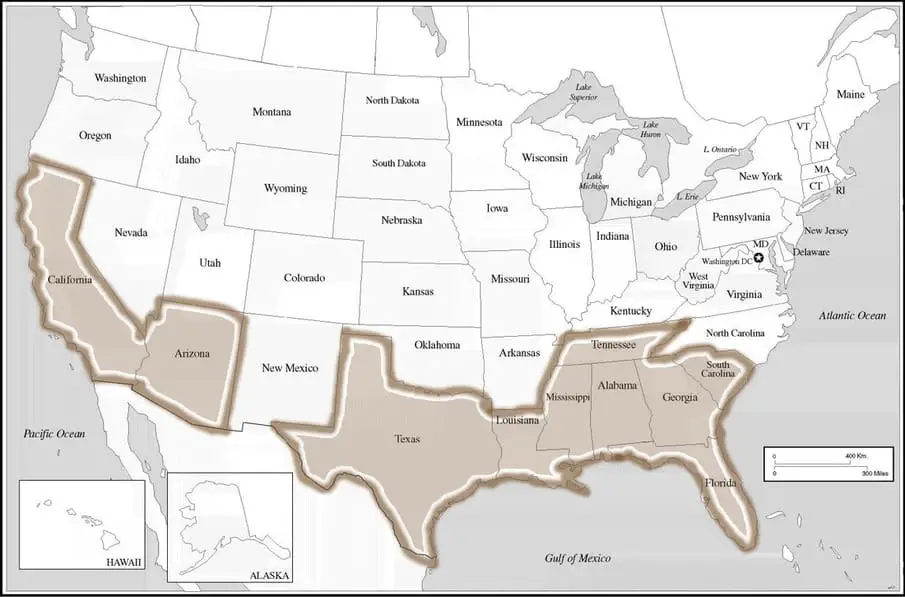Latrodectus geometricus, commonly called the brown widow spider, is one of the most common widow spiders that can be found in the United States. Its range is restricted to the warm Southern States ranging from California to Florida and South Carolina as well as Hawaii. It is not a native US species and has been brought in from Africa where it is called the button spider. Over the last years, the brown widow has spread greatly, especially in Southern California. In some areas, the spider has become so invasive that is has pushed the more dangerous native Western black widow out of its habitat.
Similar to the Northern black widow, the Western black widow and the Southern black widow, the brown widow’s bite transfers a strong venom that can cause strong symptoms. However, the brown widow is considerably less dangerous than its black widow relatives.
Brown Widow Description
Like all other North American widow spiders, the Brown Widow has a characteristic hourglass shape on its bottom. In contrast to the markings of its relatives, the hourglass shape of the brown widow is usually orange or light read instead of a dark red. Its legs are light brown with several black rings around it.

The back of the abdomen is adorned with several black, brown and red markings. These markings have led to its scientific species name L. geometricus.
A great way to identify a brown widow and to distinguish it from the similar looking, but harmless, Steatoda triangulosa cobweb spider is its egg sac. The egg sacs of the brown widow are spiky or tufty.
Size
An adult female brown widow reaches a size of around 0.5 inches (13 mm). The total leg span can be up to 2 inches (50 mm). The male is generally slightly smaller than the female.
Web
Like the other widow spiders, the brown widow spins erratic and tangled-looking webs. In many cases, the spider can be found hanging upside down in the center of the web. This reveals the hourglass shape on the bottom of its abdomen.
Brown Widow Bite
Most bites from brown widows occur when the spider feels that it is in danger and is trying to defend itself or its egg sac. Therefore, you should never touch the web of a widow with your hands. Generally, brown widow bites rarely occur, as the spider will rather run away from humans than attack them. As mentioned above, the bite of a brown widow is less severe than the bite of a black widow. The strong pain is usually limited to the direct area of the bite.
The spider doesn’t inject venom with every bite. However, if you have been bitten and you feel a strong pain, muscle cramps or nauseous, head to the nearest hospital immediately.
Range of the Brown Widow in the United States

The Brown Widow likes warm temperatures and can only be found in the Southern states of the USA. These are: Alabama, Arkansas, California, Florida, Georgia, Hawaii, Louisiana, Mississippi, South Carolina, Tennessee and Texas.
Scientific Classification of Latrodectus geometricus
- Kingdom: Animalia
- Phylum: Arthropoda
- Subphylum: Chelicerata
- Class: Arachnida
- Order: Araneae
- Infraorder: Araneomorphae
- Family: Theridiidae
- Genus: Latrodectus
- Species: Latrodectus geometricus
Other common names
Other common names of the brown widow are brown button spider, house button spider, brown black widow, gray widow, geometric widow and geometric button spider.


This spider has spun its Webb in my very small backyard. Is it poisonous, and how do I encourage it to move on or the dispose of it?
Hello Leila,
This is a banana spider or golden-silk orb weaver (Trichonephila clavipes). It’s not medically significant. It can be safely moved with a glass/cup and a piace of paper. It will rebuild its web somewhere else. You can read more about it here: https://usaspiders.com/trichonephila-clavipes-banana-spider/
Found in coastal se georgia
Hello Jaime, thanks for reaching out! This is almost definitely a brown widow (Latrodectus gemoetricus) – the orange on the picture probably looks like an hourglass shape. Even though brown widows are a close relative of black widows, they are not considered medically significant. As all spiders, it should be handled with care but can be relocated safely with a glass and a piece of paper. Here is more information about them: https://usaspiders.com/latrodectus-geometricus-brown-widow/
This is outside my front door 9/11/2021, from the pics shown on this site I think its a brown widow. But want to be sure which is why I’m sending a pic. Thank you for your help take care.
Hello C, thanks for getting in touch! Even though the image is a little blurry, making a confident ID hard, I am fairly certain that this is a brown widow.
I have a few of these spiders around. This picture was taken of the spider on its web in my garage window. This is in northeast Wisconsin.
This is an orb weaver
I found this guy in southeast Kansas. This is the underbelly.
usaspiders
October 7,2021 at 2:20 pm
Hello
Saw these spiders under my RV. Is the one with the orange markings a brown widow spider?
usaspiders
October 7, 2021 at 2:20pm
Hello, can you tell me if the one with orange markings a brown widow?
Found this here in Los Angeles north Hollywood and wondering what it is because there are lots of them around my house
Hello Dmk, thanks for getting in touch! This is a brown widow (Latrodectus geometricus): https://usaspiders.com/latrodectus-geometricus-brown-widow/
In contrast to black widows, brown widows are not medically significant.
Hi there! I found this guy in my son’s bedroom about a month ago and relocated him outside on my patio. Since then, he’s doubled in size. As long as he stays outside, I’m ok with him hanging around (no pun intended). Just curious is all. I’m in western Washington state on the Oregon boarder. Thanks.
Spider found in an outside storage box.
Hello Robert, what a great shot! This is a female brown widow. Contrary to black widows, brown widows are not considered medically significant as they deliver a smaller amount of potent venom.
https://usaspiders.com/latrodectus-geometricus-brown-widow/
Hello, found two of these spiders in our green waste bin, smallish between a penny and nickel in size and the other side of their back end has a sort of white/cream striping. Web was erratic.
Hello Louis, thanks for sharing this great shot! This is a brown widow (Latrodectus geometricus). In contrast to their relatives, the black widows, brown widows are not considered medically significant: https://usaspiders.com/latrodectus-geometricus-brown-widow/
An incredible series of images of this brown widow taken in San Diego, CA just on the outskirts of downtown. Unfortunately these had taken over the neighborhood and as you can see had no problems catching and eating a 1.5″ cockroach. (I have video of it too)
Found on patio furniture in backyard. Live in Ventura County, CA.
Please let us know what it is.
Thanks!
Hi Kellie, this is a brown widow (Latrodectus geometricus):
https://usaspiders.com/latrodectus-geometricus-brown-widow/
If you are interested in learning more about spiders in California, check out our California spider identification and information book – available as an ebook here or as a printed paperback on Amazon.
I found this brown widow in my pool area. We’re located in Oklahoma around Oklahoma City area. You might need to revise the areas they are found in.
Spider is smaller than a dime. Found outside in breezeway on a post. Moved it to flower bed.
found this spider under my dinner chair in the dining room.
Hi Patrick, this looks like a brown widow spider (Latrodectus geometricus): https://usaspiders.com/latrodectus-geometricus-brown-widow/
Thank you for identifying. Would this be a male or just a juvenile? I had to zoom the pic pretty big as it was pretty small.
Patrick
Outside the shop with three egg sacks here is South GA.
Hi there… so nice to find you on the net.
I have a bunch of these in my mailbox. Lake Forest, CA, USA
Can’t find it anywhere. Interesting pattern on its back.
Hi Maurice, thanks for sharing this great shot! This is a brown widow (Latrodectus hesperus). They are close relatives of the black widow but their venom is less potent and they are not considered medically significant. i would still recommend handling them with care to avoid getting bitten.
You can learn more about them here: https://usaspiders.com/latrodectus-hesperus-western-black-widow/
If you are interested in learning more about spiders in California, check out our California spider identification and information book – available as an ebook here or as a printed paperback on Amazon.
Hello. I’m in Spring, Texas and it’s unbelievably hot this summer. I found this spider on the wall of the backyard part of the house. Please help me identify it, as I have 4 dogs and one is quite elderly ( 17) . I’m afraid it may be a brown widow spider.
Those are common here in NE Georgia, and have many names. The zigzag in the web gives them a nickname known as the “writing spider”, although they look deceivingly similar to a banana spider, they are NOT the same. banana spiders actually have yellow webs and lack the zigzag formation. Plus, they are significantly bigger, have squarish abdomens, and live in warmer tropical/coastal environments. That is simple a yellow and black garden spider. Their venom is not harmful and they kill pests in gardens.
Im not an expert but I can assure you that’s not a brown widow. They’re commonly know as “banana spiders” in my area (south Alabama).
If it’s built a home where someone could walk thru its web, I’d help it relocate with a broom. Free pest control!
Their bites aren’t toxic to humans like black/brown widows but they’re big buggers with big fangs. If bit, along with the localized swelling, you could get a secondarily bacterial infection and might need antibiotics.